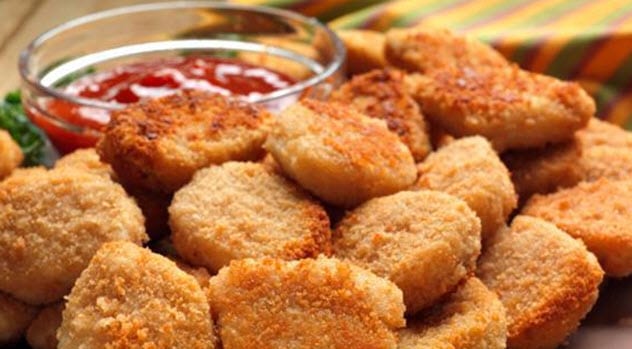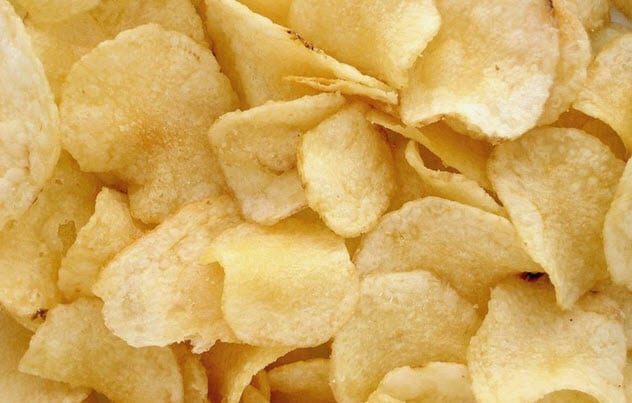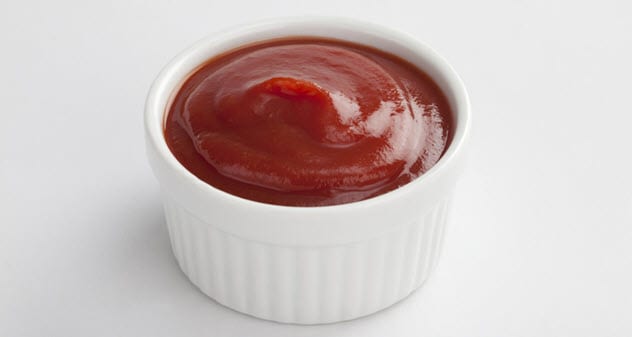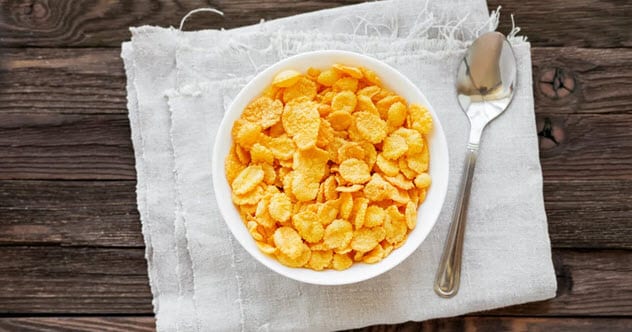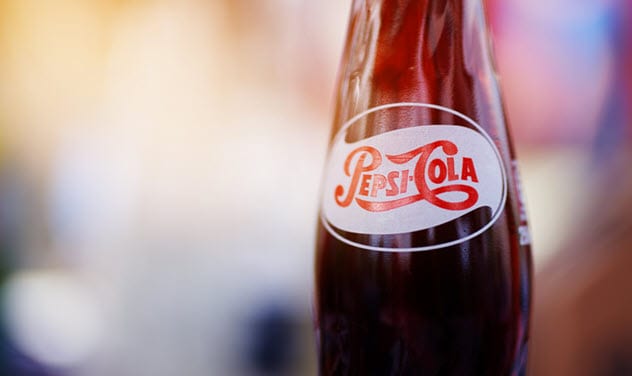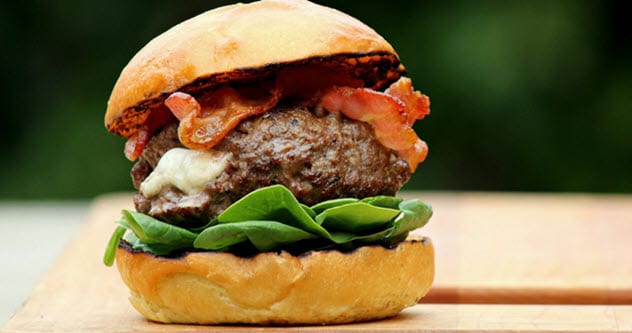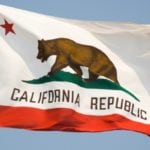In the past, people had no choice but to prepare all their own meals from scratch. This required time, skill, and effort. If no one in the family could cook, the family would starve. And since raw ingredients are so perishable, they couldn’t be stored for very long. At the turn of the 20th century, the industrial boom and the invention of refrigeration led to one of the greatest products of the modern age: processed food. Ready-made and easy to prepare, processed foods are the savior of the busy parent, bad cook, and poor student alike. Processed foods (so-called because they are made in a factory) bring with them many conveniences such as long shelf lives, very short preparation times, and cheap prices. Despite associated health concerns, they’ve done more to make good-tasting, high-calorie food available to people on low incomes than any other invention in history. As they’re so new, we usually know who invented them. Some have much more unusual and interesting backgrounds than others. Let’s take a look at some of the strangest stories behind the inventions of 10 popular modern foods.
10 Chocolate Bar
Today, we can’t even walk into a small convenience store without being tempted by a whole display of different chocolate and candy bars produced and packaged for our convenience and ready to eat. In the past, however, almost all candies were sugar based and stored in containers in candy shops. There, customers would bag and buy a requested weight of sweets for a set price. While stores like this still exist today, they are largely novelty shops. But before the invention of the chocolate bar, this was the norm. This all began to change in 1847 when Joseph Fry discovered a way to combine cocoa and sugar in a way that allowed them to be shaped into a solid bar. John Cadbury followed suit, and both men displayed their chocolate bars to the world at a trade fair in Birmingham, England, in 1849. Chocolate bars were an instant hit, and several other companies like Terry’s and Rowntree’s appeared over the course of the Victorian age. The competition between these companies led to many innovations, including the first Easter egg in 1873, the first box of heart-shaped Valentine’s chocolates in 1868, and the first mass-produced chocolate bar, Fry’s Chocolate Cream, in 1866. Over the course of the century, Fry’s alone released over 200 different chocolate candy products.[1] One of the major issues with chocolate, of course, is that it tends to melt in hot temperatures. Alongside increased mass production, this fueled the transition from traditional candies sold by weight to the modern individually priced and packaged candies we’re used to today.
9 Chicken Nugget
Chicken nuggets are ubiquitous across the Western world. From Poland to the United States, you can buy chicken nuggets in nearly every town center or highway service station. They are one of the most consumed fast foods available today and can even be found in supermarkets. They have conquered the culinary world—not bad considering they’ve only been around since 1980. McDonald’s started selling McNuggets that year after some initial experiments. According to McDonald’s itself, they first decided they wanted to sell chicken after the US government released its first dietary advice in 1977. The report urged people to eat less fat, which led to a drop in burger sales. McDonald’s decided to switch to chicken—a leaner, less fatty meat—to shore up their profits. They experimented with several chicken products, including a chicken pot pie, before moving on to coated onion chunks, an alternative to onion rings. After that failed, they settled on coated chicken chunks, which they called McNuggets.[2] What’s unusual about this story, however, is that chicken nuggets had been invented by Professor Robert C. Baker around 18 years earlier. Baker, who had grown up in the Great Depression, was a food scientist who was working for entirely different reasons. Since he, like many others at the time, was nearly always hungry as a child, his goal was to produce the highest-calorie food for the lowest price possible. He experimented with many of the staples of fast-food restaurants today, including barbecue sauce, but soon settled on the poultry industry. Chicken meat sales boomed during World War II because of the need to feed the soldiers. But the war’s end left many poultry farmers high and dry. Baker wanted to rejuvenate the industry and made over a dozen different chicken products. He designed logos for and tested each product in local shops to see which sold the best. He published his findings in scientific journals to encourage producers. His reports were sent to over 500 companies at the time. Although McDonald’s doesn’t mention him in their history of the chicken nugget, it’s likely that they were inspired by his research somewhere along the line.
8 Potato Chips
Although the creation of the potato chip is disputed, it is alleged to have occurred on August 24, 1853. George Crum—a half-African, half–Native American man—was working at a resort in Saratoga Springs, New York, as a cook. He received an order for some french fries, but the customer kept sending back his order, complaining that they were “too thick.” In frustration, Crum apparently sliced up some potatoes really thin and dumped them in the fryer, cooking them to a crisp. To his surprise, the customer loved them. And to top it off, the customer was apparently Cornelius Vanderbilt, the extremely wealthy railroad tycoon. While the story certainly sounds like fiction, there may be a hint of truth to it. George had a sister, Kate Speck Wicks, whose obituary outright states that she was the first person to create “Saratoga Chips,” as potato chips used to be known. Saratoga Chips were a Saratoga Springs local delicacy for some time before they started to spread across the United States. They were still a restaurant or diner food until William Tappenden turned his barn into the world’s first chip factory in 1895. They grew increasingly popular over the coming decades until Herman Lay sprang onto the scene in the 1930s. He quickly becoming the leading producer of mass-produced and packaged chips.[3]
7 Chocolate Chip Cookie
Cookies have been around for hundreds of years. First invented in Persia over 1,000 years ago, they didn’t spread to the West until much later when sugar became more accessible. The earliest European cookie was the Jumble, which was often used as travel food. It was made from nuts, flour, eggs, and sugar. They were brought to the Americas by the Dutch in the early 1600s. The Dutch word for them, koekje, evolved over time to become cookie. But what are cookies without a few chocolate chips, right? Chocolate chip cookies are eaten all over the world today, but they were actually invented by complete accident. Ruth Graves Wakefield was a skilled cook and dietitian and frequently lectured on food. She also ran the Toll House Inn in Massachusetts with her husband. She prepared all the food served at the inn and was known for her wide selection of impressive desserts. One day in 1930, she started to bake some chocolate cookies. Partway through, Wakefield discovered that she was out of baker’s chocolate. In a hurry, she substituted some Nestle chocolate. This didn’t blend as well as she had expected, and by the time the cookies were done, they were peppered with small chunks of chocolate. They were such a hit that Wakefield created a recipe for them and began advertising it in local newspapers. The recipe, which Wakefield called the Chocolate Crunch Cookie, became wildly popular after being featured in an episode of The Betty Crocker Cooking School of the Air on the radio. The cookies were so successful that they actually increased the sales of Nestle chocolate. As a result, Nestle and Wakefield struck a deal. Nestle would provide her with a lifetime supply of free chocolate if they could reprint her recipe on their packaging. Nestle still sells bags of Nestle’s Toll House Chocolate Morsels, and the original recipe still appears on the back.[4]
6 Tomato Ketchup
Tomato ketchup is a condiment close to our hearts. According to one survey, 97 percent of US households have a bottle of it in their house. Each of us eats three bottles of ketchup every year on average, and it is the second-most popular sauce in the US behind mayonnaise. We might think that ketchup has been on our tables for hundreds of years, but it is actually a relatively modern invention.[5] The Western world first encountered the tomato in the late 1400s when Columbus discovered the Americas. But its strange, hostile appearance, combined with popular rumor, meant that most people were convinced that tomatoes were poisonous. Although they entered Italian and Spanish cuisine first, they weren’t commonly eaten in Europe and the US until the 1800s. Meanwhile, ketchup had been consumed in Europe since the 1600s when traders first made contact with China. The adventurous merchants brought back with them a tangy fish-based sauce called ke-tsiap. It was instantly popular. Many recipes appeared trying to replicate the sauce, adding ingredients from anchovies to mushrooms. The closest thing to this early ketchup is Lea and Perrins Worcestershire Sauce, which is still popular today. The first tomato ketchup seems to have been made by James Mease in 1812. But tomatoes don’t preserve well, so early tomato ketchups went off quickly. Even as late as 1866, the French chef Pierre Blot urged people not to buy commercial ketchup, describing it as “filthy, decomposed, and putrid.” In response, many companies started adding large amounts of early preservatives, many of which were dangerous to people’s health. The final stage of the ketchup story came in the early 1900s when Dr. Harvey Washington Wiley went into business with Henry Heinz. They introduced a tomato ketchup in 1906 which replaced preservatives with vinegar to extend shelf life without harming people’s health. It was an instant hit. Heinz was producing 13 million bottles per year by 1907.
5 Cornflakes
Breakfast cereals have a long and storied history. For hundreds of years, it was common to eat porridge or wheat in the morning before a day of work. These were nearly always prepared by hand, though. As the industrial revolution progressed, Quaker Oats was the first company to commercially produce and sell oats, starting in 1854 and expanding rapidly after 1877. But the ready-to-eat cold cereals that we know today didn’t come along until much later. First invented by John Kellogg, cornflakes were not produced and sold commercially until his brother, Will Kellogg, formed his own company and started selling them in 1906. John Kellogg was an unusual man even by Victorian standards. A mental and physical health doctor, he strongly believed that sex was harmful to mental, emotional, and physical well-being. He personally abstained from sex and never even consummated his marriage. In fact, he and his wife had separate bedrooms and all their children were adopted. He particularly despised masturbation, which he asserted caused all kinds of illnesses from general infirmity to epilepsy. As part of his crusade to curb masturbation, he created cornflakes. At the time, many people chose to eat meat at breakfast, which Kellogg believed enhanced sexual appetite. He believed that eating plainer foods in the day would reduce sexual behavior. With this in mind, he introduced cornflakes at Battle Creek Sanitarium in the 1890s. It was his brother, Will Kellogg, who saw the economic potential. He urged his brother to add sugar to them, which John was adamantly against. After years of working together, Will broke with his brother in 1906 and began selling Cornflakes as the flagship product of his new business, the Kellogg Company.[6]
4 Pepsi
Coca-Cola is undoubtedly the most famous soft drink in the world, closely followed by its persistent rival, Pepsi. Most people assume that Pepsi was a copycat brand that tried to duplicate Coke’s success, but they actually started as two completely different products. The two soda giants have been battling each other for over 100 years in what is possibly the longest commercial duel in history. When Coca-Cola was first developed, chemists and pharmacists commonly had drinking fountains in their stores which freely dispensed carbonated water. At the time, people believed that carbonated water could cure a wide range of illnesses and health problems. As chemists would often experiment to create new medicines, many decided to put their experimental drinks in their fountains for people to try. John Pemberton, the creator of Coca-Cola, patented and sold it as a carbonated medicine which quickly grew in popularity. It was first advertised in 1886. By contrast, Pepsi was created by pharmacist Caleb Bradham who initially provided it for free in his pharmacy’s fountain. At the time, he simply called it Brad’s drink. It was very popular with his customers. By 1903, he’d changed the name to Pepsi-Cola and was selling it to pharmacies across the country. The great rivalry was born. Unfortunately for Pepsi fans, Bradham’s company went bankrupt in 1923 and he went out of business. Coca-Cola was offered the chance to buy Pepsi three times between 1922 and 1933 and declined each time.[7] After a decade of failures, Pepsi was reborn in the Great Depression when it began using 355-milliliter (12 oz) bottles instead of Coke’s 177-milliliter (6 oz) ones. The value for money was incredible in such hard times, and Pepsi became wildly popular. It retained its position through effective marketing and business acumen and remains Coca-Cola’s chief competitor to this day.
3 Hamburger
Burger patties might seem like a modern invention, but they have actually been around for hundreds of years. The first appearance of mincemeat is in a record from the fourth century in a Roman cookbook known as the Apicius. But the book was a private project of one of the most infamous foodies of all time and almost certainly didn’t contain common Roman foods. The beef patty appears again in the 1200s when Mongol warriors put raw beef under their saddles. The meat was tenderized and even partly cooked by the friction created by horse riding. The massive size of the Mongol Empire meant that their curious practice of mincing meat came into contact with many different cultures, but it became especially popular in medieval Russia. By 1300, it had reached Germany, allegedly brought there by Russian merchants arriving in the port of Hamburg. Minced beef recipes exploded across the German-speaking world over the next few hundred years. Many new ingredients were added. But while it was sometimes served alongside toast, minced beef was never served in the form of the modern hamburger as we know it today. The recipe for the Hamburg steak was brought to America by German immigrants from 1840 onward. By 1880, both Frank and Charles Menches in New York and Charlie Nagreen in Wisconsin had developed a patty-on-a-bun version of the meal. Even then, it spread relatively slowly across the US. The first burger chain didn’t appear until 1921, and the “cheeseburger” finally graced us with its presence at the Humpty Dumpty Drive-In in 1935.[8]
2 Nutella
Nutella is one of the most popular sandwich spreads in the world. The manufacturer, Ferrero, uses over a quarter of the world’s entire supply of hazelnuts. The success of Nutella actually made CEO Michele Ferrero the richest person in Italy and the 20th richest person in the world. Despite its success today, Nutella was first created through necessity. During World War II, cocoa was a rare and expensive ingredient in Italy. Michele’s father, Pietro, capitalized on this. He made a sweet paste that was predominantly hazelnuts and sugar as an alternative to expensive chocolate spreads. He called this product Giandujot. A few years later in 1951, the formula was altered to turn it into a spread. They repackaged it in a jar and named it SuperCrema. But it was Michele who turned it into the Nutella with which we’re familiar. He knew that the recipe could be improved and, through trial and error, revamped the spread by adding vegetable oil and palm oil.[9] The first jar of this new Nutella left the factory in 1964 and became an instant hit. Michele personally created the first recipe. Before he died in 2015, he had turned his father’s single-shop business into a global food empire. The Ferrero company is still owned by the Ferrero family.
1 Popsicle
The invention of the Popsicle is a strange story that almost sounds like fiction. It was created by accident on the front porch of an 11-year-old boy named Frank Epperson. It was 1905, and Frank had made himself a drink by combining soda powder and water in a glass with a small wooden stirrer. Being just a child, he forgot about his drink and left it out overnight. The temperature dipped below freezing. When he went back out the next morning, he discovered that he’d created the world’s first Popsicle. He named it the Epsicle and started selling them to other children in his neighborhood. After reaching adulthood, Frank forgot about the Epsicle and became a lemonade salesman. Then he embarked on a career as a realtor with the Realty Syndicate Company in Oakland, California. However, he brought the invention back in 1922 when he made some ice pops to take to a local firemen’s ball. They were really popular. The following year, Epperson applied for a patent, which he received in 1924, for “a handled, frozen confection or ice lollipop.”[10] He then started selling them at the Neptune Beach amusement park in seven different flavors. Unfortunately, he fell on hard times financially and was forced to sell his patent to the Popsicle Corporation in 1929.

